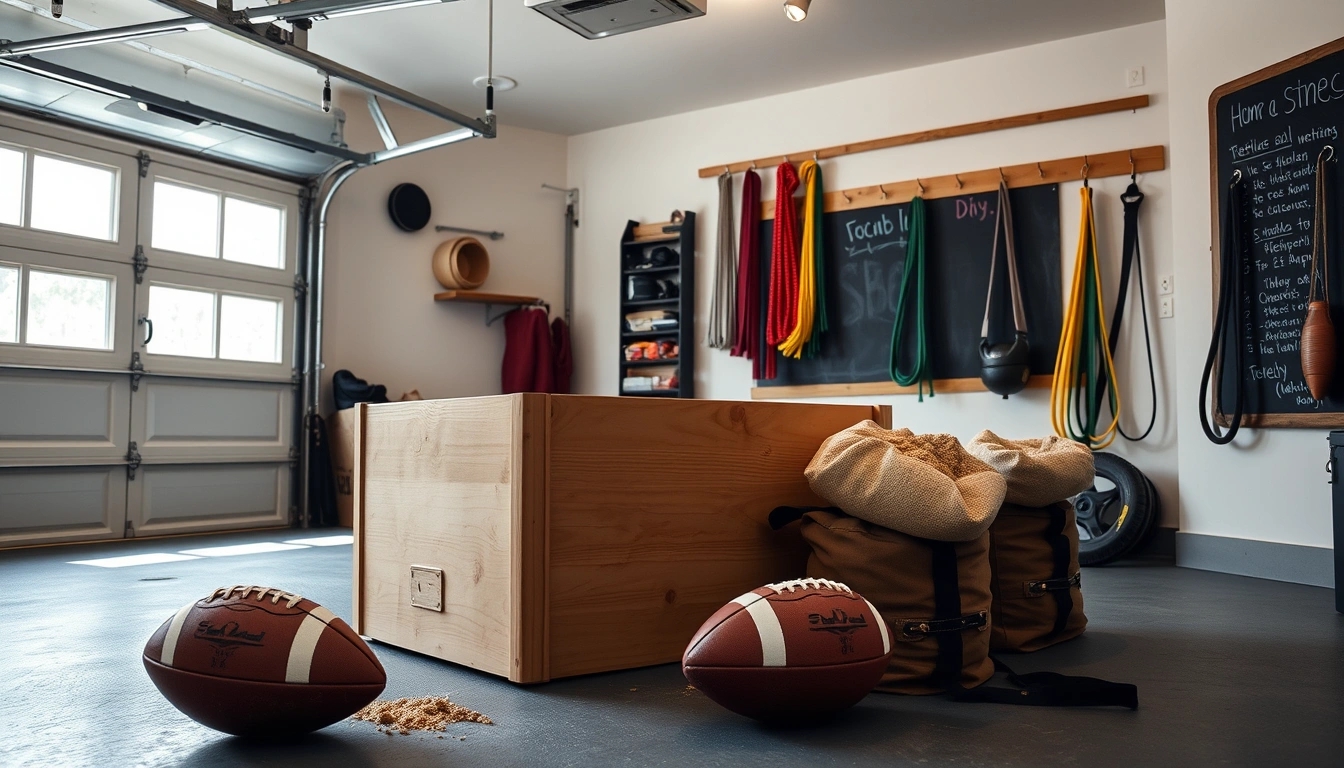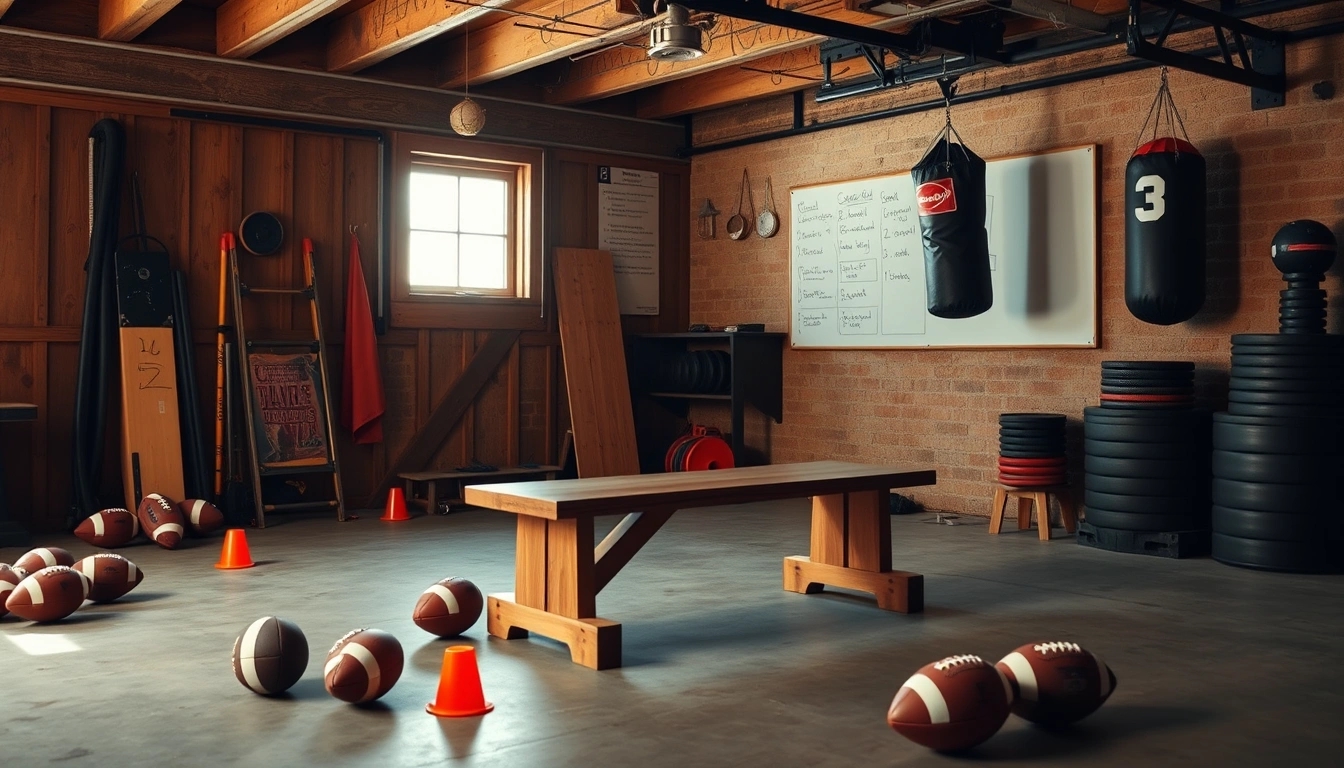Alright, so you want to build a football gym right in your own house but don’t have a fat wallet to splash cash on fancy gear? No worries, mate, it’s totally possible to get yourself set up without selling a kidney or two. The trick is to be smart, resourceful, and maybe a bit crafty. Let’s dive into how you can kick off your football training space without breaking the bank.
Setting Realistic Goals First
Before you start throwing money at every shiny piece of equipment, take a breath and figure out what you actually need. Are you focusing on speed, strength, endurance, or all of the above? Pinpointing your priorities saves you from buying stuff that will just gather dust. For example, if your speed needs work, agility ladders and cones are your best friends — and they don’t cost an arm and a leg.
Essential Equipment That Won’t Kill Your Budget
Here’s a quick rundown of the essentials that won’t leave you penniless:
- Weights and Resistance Bands: Super versatile, these help build strength and explosiveness. Resistance bands, in particular, are dirt cheap and pack a punch.
- Agility Tools: Think cones, ladders, and hurdles. You can find affordable sets online or, better yet, DIY them with stuff around your house.
| Equipment | Approximate Cost | Why You Need It |
|---|---|---|
| Resistance Bands | $10 – $20 | Builds muscle, improves flexibility |
| Agility Ladder | $15 – $25 | Enhances footwork and speed |
| Weighted Vest | $30 – $50 | Increases resistance during drills |
DIY Solutions: Because Who Doesn’t Love a Good Hack?
If you’re strapped for cash but rich in creativity, this is your playground. Grab some old crates or pallets and boom — instant plyometric boxes. Weighted vests? Fill an old backpack with some sandbags or water bottles. Homemade sleds? Use a sturdy board and attach some weights or heavy stuff you’ve got lying around. Not exactly Instagram-worthy, but hey, it works.
- Homemade Weighted Vest: Use a backpack, fill it with sandbags, rocks, or water bottles. Adjust weight as needed.
- Improvised Plyometric Boxes: Stack crates or pallets securely to practice jumps and boosts.
- DIY Sled: Find a flat, durable board, add weight, and drag it across your yard or driveway.
Space Optimization Tips
If your “gym” is basically a corner of your bedroom or garage, don’t sweat it. Use foldable or stackable equipment. Resistance bands take up zero space and ladders can be rolled up and tucked away. Keep your gear organized with hooks or shelves so you’re not tripping over dumbbells when you’re trying to sprint.
Tech Without Breaking the Bank
You don’t need a personal trainer to keep you honest. There are tons of free apps and YouTube channels dedicated to football training. Follow along for drills, workout plans, and motivation — all for zero dollars. Just watch out for those “miracle” programs that want to charge you $99.99 after a free trial. No thanks.
Maintenance & Safety
Don’t forget to keep your gear in good shape. Clean your bands, check your DIY boxes for stability, and always warm up properly. Injuries suck and can totally derail your progress.
Fuel and Recovery on a Budget
You don’t need to buy fancy protein powders or supplements. Focus on balanced meals with plenty of protein from eggs, beans, or chicken. Hydrate like a champ and get enough sleep — your body will thank you.
Tracking Progress
Grab a notebook or use your phone’s notes app. Write down your reps, times, and how you feel. Seeing your progress written down is a killer motivator.
In the end, building a home football gym on a budget is all about being smart, creative, and consistent. You don’t need the fanciest gear to train hard and improve. Just get moving, stay motivated, and watch your game soar.
Setting Realistic Goals for Your Home Football Gym
Alright, before you go all-in and blow your paycheck on the latest, shiniest football gear, take a breath and think this through. Building a home football gym isn’t about stacking your room with every gadget under the sun. It’s about figuring out what you truly need to sharpen your skills and boost your fitness without tossing money down the drain. Sounds obvious, right? But you’d be surprised how many folks get caught up in the hype and end up with fancy equipment that collects dust faster than you can say “touchdown.”
So, first things first: ask yourself what your goals really are. Are you trying to improve your speed? Build raw power? Or maybe you want to work on agility and endurance? Pinpointing your priorities helps you avoid buying stuff that looks cool but doesn’t actually serve your purpose. For example, if you’re all about increasing your explosive power, investing in a heavy sled or resistance bands might be smarter than splurging on a treadmill that’s gonna bore you to tears.
| Goal | Recommended Equipment | Why It Matters |
|---|---|---|
| Speed & Agility | Agility ladder, cones, hurdles | Improves footwork and quickness on the field |
| Strength & Power | Resistance bands, dumbbells, homemade sled | Builds muscle and explosive force |
| Endurance | Jump rope, cardio routines with apps | Boosts stamina to last all four quarters |
Now, here’s a fun fact: you don’t need a massive space or a fancy gym membership to get results. Sometimes, less is more. Setting realistic goals also means being honest with your space and time constraints. If your apartment’s the size of a shoebox, you can’t exactly set up a full obstacle course. But hey, a simple corner with a jump rope and some resistance bands can still do wonders.
- Tip #1: Write down your main objectives and prioritize them.
- Tip #2: Think about what exercises you enjoy — forcing yourself to use equipment you hate is a fast track to quitting.
- Tip #3: Consider your budget — it’s tempting to overspend, but smart investments pay off in the long run.
And don’t forget, progress isn’t always linear. You might start with a plan to build strength but realize halfway through that agility is your weak spot. That’s okay! Flexibility in your goals is key — it keeps you from getting stuck or frustrated.
"Set your goals like a coach calls plays — clear, strategic, and ready to adjust when the game changes."
In the end, setting realistic goals is your secret weapon. It stops you from wasting cash on gear that’s just gonna gather dust and helps you focus on what really moves the needle for your football game. So, take a moment, think it over, and plan smart. Your wallet and your future self will thank you.
Essential Equipment That Won’t Drain Your Wallet
Alright, let’s get real for a moment. Setting up a football training space at home sounds fancy, but most folks think it means dropping big bucks on shiny gear. Nah, that’s not the only way. You can snag some must-have training tools that don’t leave your wallet gasping for air. The trick? Finding that sweet spot between affordability and functionality — gear that actually works and won’t break the bank.
First up, weights and resistance bands. These bad boys are the bread and butter of any football gym setup. Dumbbells, kettlebells, or even adjustable weights can be found at reasonable prices, especially if you’re cool with second-hand stuff or hunting deals online. Resistance bands? They’re like magic — super cheap, crazy versatile, and they take up zero space. You can do strength training, explosive moves, and even rehab exercises with them. No fancy machines needed.
| Equipment | Why It’s Essential | Average Price Range |
|---|---|---|
| Dumbbells/Kettlebells | Builds strength, power, and endurance | $20 – $70 per set |
| Resistance Bands | Improves flexibility, strength, and rehab | $10 – $30 |
| Agility Ladder | Enhances footwork and speed | $15 – $40 |
| Cones & Hurdles | Great for drills and agility training | $10 – $50 (set) |
Now, speaking of speed and agility, don’t overlook the agility ladder, cones, and hurdles. You can literally DIY some of these with stuff around the house or score them dirt cheap online. These tools are fantastic for sharpening your footwork, reaction time, and quickness — all crucial for football players. Plus, they’re lightweight and easy to stash away when you’re done.
- Agility Ladder: Perfect for quick feet and coordination drills.
- Cones: Mark out drills or set up mini obstacle courses.
- Mini Hurdles: Great for plyometric and explosive training.
Here’s a little pro tip: if you’re strapped for cash, don’t hesitate to get creative. Old ropes can turn into agility ladders, empty plastic bottles can become cones, and sturdy sticks or broom handles can work as hurdles. Trust me, it’s not about having the fanciest gear — it’s about consistency and using what you’ve got smartly.
And hey, don’t forget the simple stuff like a good jump rope. It’s crazy cheap, portable, and killer for cardio and coordination. A few minutes a day skipping will have you feeling like a champ on the field.
Budget Gear Checklist:- Dumbbells or Kettlebells- Resistance Bands- Agility Ladder (or DIY version)- Cones (or plastic bottles)- Mini Hurdles (or broom handles)- Jump Rope
In the end, the goal is to build a setup that pushes your limits without pushing your finances over the edge. You don’t need a full gym to get results — just a handful of smart, affordable tools that help you train hard and stay consistent. Remember, it’s not the price tag that makes the player, but the grind and hustle behind the scenes.
So, get out there, grab what you can, and start turning that home space into your personal football fortress — no bank-breaking required.
Weights and Resistance Bands
Alright, let’s get real about building strength for football without blowing your entire paycheck on fancy gym equipment. Weights and resistance bands? Yeah, they might sound basic, but they’re absolute game-changers when it comes to boosting your power and explosiveness on the field. And the best part? They won’t leave your wallet crying in the corner.
First off, free weights like dumbbells and kettlebells are the bread and butter of any home gym setup. You don’t need a full rack of barbells or those intimidating machines that look like they belong in a sci-fi movie. Just a couple of adjustable dumbbells or a set of kettlebells can cover a ton of ground. You can do everything from squats, lunges, and presses to deadlifts and rows. And here’s the kicker — these moves build functional strength that directly translates to better tackles, faster sprints, and more explosive jumps.
- Why weights? Because muscle strength isn’t just about looking good; it’s about injury prevention and dominating your opponents.
- Pro tip: Start light, focus on form, and gradually up the weight. No one became a beast overnight.
Now, resistance bands might seem like the underdog in this story, but don’t underestimate them. These stretchy little guys are insanely versatile and perfect for adding resistance without the bulk. Plus, they’re portable as heck — toss them in your bag and train anywhere. From lateral walks to banded sprints and explosive push-offs, resistance bands help improve your speed, agility, and power without needing a whole gym setup.
| Equipment | Benefits | Approximate Cost |
|---|---|---|
| Dumbbells (Adjustable) | Builds overall muscle strength, improves tackling power, enhances endurance | $50 – $150 |
| Kettlebells | Improves explosive strength, core stability, and grip | $30 – $100 |
| Resistance Bands | Portable, versatile, great for speed and agility drills | $10 – $40 |
Here’s a little secret: combining weights and resistance bands in your training routine can seriously up your game. For example, after a set of weighted squats, throw in some banded lateral shuffles to engage those hip muscles that often get ignored but are crucial for quick cuts and direction changes.
Sample Workout Circuit:- Dumbbell Goblet Squats: 3 sets of 12 reps- Resistance Band Lateral Walks: 3 sets of 20 steps each side- Kettlebell Swings: 3 sets of 15 reps- Resistance Band Push-Offs: 3 sets of 10 explosive reps
Also, don’t get too hung up on the “perfect” equipment. If you’re strapped for cash, check out secondhand stores or online marketplaces — you’d be surprised how many barely used weights and bands you can snag for a steal. And hey, if you’re feeling crafty, DIY weighted vests or sandbags can be a fun project to add resistance without spending much.
So yeah, weights and resistance bands might not look flashy, but they’re the unsung heroes in your home football gym. They build the kind of strength and explosiveness that’ll have you breaking through tackles and sprinting past defenders like a pro — all without draining your bank account. Just remember: consistency beats fancy gear any day.
Bottom line: Invest smart, train hard, and watch your game explode — no need for a fancy gym membership when you’ve got these trusty tools in your corner.
Agility and Speed Training Tools
When it comes to sharpening your footwork and boosting speed, you don’t need to drop a fortune on fancy equipment that collects dust after a week. Honestly, some of the best tools for agility training are surprisingly affordable — and if you’re feeling a bit crafty, you can DIY your way to a killer setup without breaking the bank.
Let’s talk ladders first. Agility ladders are absolute classics in any football training arsenal. They help with quick feet, coordination, and overall agility. The good news? You can snag a decent plastic or nylon ladder online or at a sports store for next to nothing. Or, if you’re the DIY type, grab some rope and flat sticks, lay them out on the ground, and boom — instant ladder. It’s not rocket science, and it works just as well to get those feet moving faster.
Now, cones. These little guys are the unsung heroes of speed drills. You can buy a set of plastic cones for cheap, but here’s a hot tip: use old plastic bottles or even upside-down cups if you’re strapped for cash. Paint them bright colors for visibility, and you’re good to go. Set them up in zigzags, straight lines, or random patterns to practice quick changes of direction — all crucial for those split-second moves on the field.
| Tool | Average Cost | DIY Option | Benefits |
|---|---|---|---|
| Agility Ladder | $10 – $25 | Rope + sticks or tape on ground | Improves foot speed, coordination |
| Cones | $5 – $15 (set) | Plastic bottles, cups, or markers | Enhances change of direction, speed |
| Hurdles | $15 – $30 (set) | PVC pipes, broomsticks on chairs | Boosts explosive power, agility |
Speaking of hurdles, these little barriers are fantastic for plyometric drills that increase explosive power and leg strength. Sure, pro hurdles can be pricey, but you can fashion your own using PVC pipes or even broomsticks balanced on chairs or boxes. It might look a bit makeshift, but hey — it’s the effort that counts, right? Jumping over hurdles repeatedly builds that quick-twitch muscle action every football player craves.
- Pro tip: Mix and match drills using these tools. For example, sprint through the ladder, weave around cones, then hop over hurdles. It’s a killer combo that keeps your brain and body sharp.
- Don’t forget to warm up properly, though. Nothing ruins a workout faster than pulling a muscle because you skipped the basics.
Lastly, if you’re wondering about space, these tools don’t demand much room. A small backyard, driveway, or even a clear patch in the park can serve as your training ground. The key is consistency — even 10-15 minutes a day can make a noticeable difference.
So yeah, agility and speed training doesn’t have to be complicated or expensive. With a little creativity and some elbow grease, you can build a home setup that’s just as effective as anything you’d find in a pricey gym. Just remember: it’s not the gear, but how you use it that counts. Now lace up those cleats and get moving — the field’s waiting.

DIY Solutions: Creative and Cheap Gym Equipment Ideas
Alright, so you’re strapped for cash but still dead set on leveling up your football training at home? No sweat. You don’t need a fancy gym membership or a pile of high-tech gear to get that grind going. Sometimes, the best workout tools are just lying around your house, waiting for a little creativity and elbow grease. Let’s dive into some DIY hacks that’ll have you sweating like a pro without emptying your wallet.
First off, think about weighted vests. Sure, buying one can cost an arm and a leg, but guess what? You can make your own using stuff you probably already own. Grab an old backpack, fill it with canned goods, water bottles, or even sandbags if you’re feeling adventurous. Secure everything tight and boom—you’ve got resistance gear that’ll challenge your muscles without breaking the bank. Just be careful with the weight distribution; you don’t want to throw your back out before you even start.
| DIY Equipment | Materials Needed | Purpose | Estimated Cost |
|---|---|---|---|
| Weighted Vest | Old backpack, canned goods, sandbags | Build strength and endurance | Almost free |
| Homemade Sled | Plastic tray, old tires, rope | Resistance training, speed | $10-$20 |
| Plyometric Box | Wooden crates, pallets | Jump training, explosiveness | Free or minimal |
Now, if you’re craving some sled training but don’t want to buy one that costs as much as your rent, try this: take a sturdy plastic tray or a piece of plywood, strap some old tires or bricks on top, attach a rope, and drag that sucker around your yard or driveway. It’s not glamorous, but it works wonders for building power and leg drive, which are key for football players. Plus, it’s a killer way to show your neighbors you’re serious about your game.
- Pro Tip: Make sure the surface you’re dragging your sled on isn’t too rough, or you’ll just wear out your DIY gear faster than you can say “touchdown.”
- Safety Note: Always check your homemade equipment for sharp edges or loose parts before you start hauling it around.
And what about those pesky plyometric boxes? Don’t have a fancy one lying around? No problem. Grab some sturdy wooden crates or pallets, stack ’em up to your desired height, and you’ve got yourself a jump station. It’s a bit rustic, sure, but it gets the job done. Just make sure your crates are solid and won’t wobble when you land—nothing ruins a workout like a twisted ankle.
DIY Plyometric Box Checklist:- Sturdy wooden crates or pallets- Sandpaper (to smooth rough edges)- Non-slip tape or mat (for safety)- Measuring tape (to get the right height)
Honestly, the magic of DIY gym equipment is that it forces you to be resourceful. You learn how to adapt, improvise, and get creative with what you have. And hey, if you mess up, it’s not the end of the world—you just build it better the next time. So next time you’re thinking, “Man, I wish I had that expensive gear,” remember: sometimes the best equipment is the one you made yourself, with a bit of grit and a lot of hustle.
Summary:
- Use household items like backpacks and canned goods for weighted vests.
- Make sleds from plastic trays and old tires for resistance training.
- Stack crates or pallets for plyometric boxes to boost explosiveness.
- Always prioritize safety and durability when building DIY gear.
Keep grinding, keep hustling, and remember—football greatness isn’t about the gear you own, but the heart and sweat you put into the game.
Homemade Sleds and Weighted Vests
Homemade Sleds and Weighted Vests: DIY Resistance Training on a Shoestring Budget
So, you want to amp up your football training without blowing your entire paycheck on fancy equipment? Well, guess what? You don’t have to! Making your own sleds and weighted vests at home is not only doable but can be downright fun (well, as fun as lugging heavy stuff around can be). Let’s dive into how you can craft these resistance training essentials from stuff you probably already have lying around.
Why bother with sleds and weighted vests? Resistance training is a game-changer for football players. It builds strength, power, and endurance, which are all crucial when you’re out there dodging tackles or sprinting down the field. Commercial sleds and vests can cost a pretty penny, but DIY versions save you money and let you customize the weight to your liking. Plus, bragging rights for making your own gear? Priceless.
- DIY Sleds: The Basics
You don’t need a fancy gym sled. A simple wooden board or an old tire rim can be turned into a sled in no time. Here’s a quick rundown:
| Materials | Instructions |
|---|---|
| Wooden board (2×4 or plywood), rope, old weights (plates, bricks, sandbags) | Attach a sturdy rope or handle to the board. Stack your weights on top, secure them with bungee cords or straps, and you’re ready to drag it across your driveway or backyard. |
| Old tire rim or sled base | Fill with sandbags or heavy objects, tie a rope for pulling, and voila! A budget sled that’ll have you sweating in no time. |
Just a heads up — rough surfaces can wear out your DIY sled fast, so keep an eye on it and maybe stick to grass or dirt for dragging.
- Weighted Vests: Bulk Up Without Breaking the Bank
Weighted vests are brilliant for adding resistance during runs, push-ups, or pull-ups. Making one yourself isn’t rocket science. Grab an old backpack or a sturdy vest, and stuff it with weights like:
- Small sandbags
- Water bottles filled with sand or water
- Heavy books or bricks wrapped in cloth
Make sure to distribute the weight evenly so you don’t end up looking like a lopsided mess. Secure everything tight with duct tape or straps to avoid shifting during workouts. And hey, if you’re feeling fancy, sew some pockets in the vest or backpack for a cleaner look.
Pro Tips to Keep in Mind:
- Start light — you don’t wanna pull a muscle or look like a newborn deer trying to walk with all that weight.
- Test your gear on soft surfaces first to avoid injuries and damage.
- Keep safety in mind: check straps and fastenings before each use.
| Advantages | Potential Drawbacks |
|---|---|
| Cost-effective, customizable, builds functional strength | Durability concerns, less polished than commercial gear, safety risks if not made properly |
In the end, homemade sleds and weighted vests are perfect for anyone who’s serious about training but not about spending big bucks. They might not win any design awards, but they’ll get the job done and keep you grinding toward your football goals. So, roll up your sleeves, raid the garage, and start building — your future self will thank you when you’re crushing those drills!
Improvised Plyometric Boxes
Look, not everyone’s got the cash to drop on those slick, professional plyometric boxes you see in fancy gyms or on Instagram fitness reels. And honestly, who needs ’em? If you’re serious about boosting your vertical leap without burning a hole in your wallet, sturdy crates and pallets are your new best friends. Yeah, you heard me right — pallets! Those rough, wooden things you usually see tossed in a corner can be transformed into legit training tools with a bit of elbow grease and a sprinkle of creativity.
First off, safety is king here. Don’t just grab any old crate or pallet lying around. You want something solid, stable, and free from splinters or loose nails — because nothing kills a workout vibe faster than a surprise trip to the ER. If you’re unsure, give it a good shake and a once-over for cracks or weaknesses. If it holds your weight without wobbling, you’re golden.
- Crates: Plastic or wooden crates can be stacked or used solo for jumps, step-ups, or box drills. They’re light enough to move but sturdy enough to handle explosive movements.
- Pallets: Usually made of hardwood, pallets can be stacked and secured to create different heights for progressive training. Just slap on some grip tape or old yoga mats on top to keep your feet from slipping.
Now, before you start thinking, “Isn’t this stuff just gonna break mid-jump?” Chill! With a bit of DIY know-how, these bad boys can hold up like champs. Here’s a quick checklist to keep your improvised box safe:
| Check | Why It Matters |
|---|---|
| Stability | Prevents tipping or wobbling during explosive jumps |
| Surface grip | Stops slipping, reducing injury risk |
| Height suitability | Matches your current plyometric level—start low, then go higher |
| Weight capacity | Ensures the box can support your body weight plus momentum |
The beauty of these DIY plyo boxes? They’re cheap, customizable, and versatile. Want to increase the challenge? Stack two crates or pallets, secure them with bungee cords or straps, and boom — you’ve got a higher box. Need a softer landing? Throw down a mat or carpet remnant. It’s all about adapting to what you’ve got, not what you wish you had.
Oh, and here’s a pro tip: use these boxes not just for jumps but for a variety of drills — step-ups, lateral hops, depth drops, and even elevated push-ups. Plyometric training isn’t just about jumping high; it’s about training your muscles to explode with power, and these boxes help you do just that.
DIY Plyometric Box Quick Guide:1. Find a sturdy crate or pallet.2. Inspect for damage, nails, splinters.3. Sand down rough edges.4. Add grip tape or non-slip mat on top.5. Test stability by pressing down firmly.6. Start with low height, progress gradually.7. Use for jumps, step-ups, lateral drills.
So next time you’re tempted to shell out big bucks for a fancy plyometric box, remember: sometimes the best training gear is right under your nose (or in your backyard). Get creative, stay safe, and watch your vertical leap soar — no fancy boxes required.
Keep jumping, keep hustling!
Space Optimization Tips for Small Home Gyms
Alright, so you’ve decided to turn that awkward corner, tiny spare room, or even a part of your garage into a football gym. But here’s the kicker — space is tight. Like, really tight. No worries, though! You don’t need a sprawling arena to get your grind on. The trick is to maximize every inch without turning your workout spot into a cluttered mess that screams “I have no idea what I’m doing.”
First up, think vertical. Walls are your best friends here. Instead of piling stuff on the floor, mount shelves or racks for your gear. Resistance bands? Hang ‘em. Dumbbells? Wall-mounted racks. Even those agility cones and ladders can be stacked or stored upright. You’ll free up floor space and keep things tidy.
- Use wall hooks and pegboards: Perfect for hanging jump ropes, bands, or even a foldable bench.
- Stackable storage bins: Keep smaller items like grip gloves, tape, and chalk organized and out of the way.
- Foldable or collapsible equipment: Look for benches or mats that fold flat when not in use.
Now, here’s a little secret: multipurpose equipment is your best bet. Instead of buying separate machines or gear for every drill, go for stuff that does double (or triple) duty. Adjustable dumbbells? Check. Weighted vests that you can wear during sprints or bodyweight exercises? Double check. Even a sturdy plyometric box that can also serve as a bench or step-up platform? Yes, please.
| Equipment | Multipurpose Use | Space Saving Tip |
|---|---|---|
| Adjustable Dumbbells | Strength training + explosive power drills | Compact, replaces multiple fixed dumbbells |
| Resistance Bands | Strength, mobility, warm-ups | Can be hung on hooks or rolled up |
| Foldable Bench | Bench press, step-ups, core workouts | Folds flat, stores under bed or shelf |
| Plyometric Box | Jump training + elevated surface for push-ups | Use crates or pallets for DIY option |
Another thing — don’t be shy about getting creative with your layout. Sometimes, the best setup isn’t obvious. Try arranging your equipment along the walls and leaving the center open for agility drills or sprints. If you’re tight on floor space, consider vertical jump ropes or wall-mounted pull-up bars that fold away when not in use.
And hey, if you’re feeling fancy (or just want to keep the clutter down), invest in a mirror. Not just for vanity — it helps you check your form and makes the room feel bigger. Plus, watching yourself crush those workouts can be a nice ego boost.
- Clear zones: Define specific workout areas even in small spaces — like a corner for weights, a spot for agility drills, etc.
- Use multipurpose flooring: Mats that protect the floor but also mark your workout zones.
- Lighting: Bright, natural-looking light makes cramped spaces feel less claustrophobic.
Look, setting up a home football gym in a shoebox-sized space ain’t easy, but with a bit of elbow grease and some smart planning, you’ll be smashing your training goals without tripping over your own gear. Remember, it’s about quality over quantity — a few well-chosen pieces used smartly beats a cluttered room full of unused junk any day.
Incorporating Technology Without Overspending
Let’s be honest, diving into the world of fitness tech can feel like stepping into a candy store with a kid’s budget—tempting, exciting, but also a little scary for your wallet. But here’s the kicker: you don’t need to drop a fortune on fancy gadgets or subscriptions to get some serious coaching and motivation. The magic of apps and YouTube channels is that they offer a treasure trove of free or dirt-cheap training plans tailored for football enthusiasts who want to level up at home.
First off, apps. There’s a ton out there, and not all of them are created equal. Some are just glorified step counters, but others? They’re like having a personal coach in your pocket, minus the yelling or awkward pep talks. You can find apps that break down drills, strength training, agility workouts, and even nutrition advice all in one place. The best part? Many of these apps come with customizable plans, so you’re not stuck doing the same boring routine every week. Variety is the spice of life, especially when you’re trying not to snooze through your workouts.
- Free apps worth checking out: Nike Training Club, Adidas Training, and FitOn.
- Affordable options with premium features: MyFitnessPal, JEFIT, and Aaptiv.
Now, onto YouTube—oh boy, this platform is a goldmine. You can find everything from pro football drills to strength and conditioning routines, all for free. Channels run by former players, coaches, or fitness nuts often share insider tips that you won’t find in generic gym classes. Plus, watching someone else sweat it out can be oddly motivating (or at least distract you from your own misery). The downside? You gotta sift through the noise to find legit content, but hey, that’s part of the fun.
| Channel | What They Offer | Why It’s Good |
|---|---|---|
| Train Like A Pro | Football-specific drills and workouts | Great for skill development and game prep |
| ATHLEAN-X | Science-based strength and injury prevention | Perfect for building muscle safely |
| Football Fitness | Cardio and agility training | Helps improve speed and endurance |
But here’s a pro tip: mix and match! Don’t just rely on one app or channel. Use apps for structured plans and YouTube for bonus drills or motivation boosts. And if you’re feeling fancy, some apps let you sync with wearable tech like smartwatches or heart rate monitors, but that’s totally optional. Remember, the goal is to keep your workouts fresh, engaging, and effective without turning your bank account into a ghost town.
Tips for Tech-Savvy Training on a Budget:- Use free trials to test apps before committing.- Create playlists of your favorite YouTube workouts.- Schedule your sessions like real appointments.- Join online forums or social media groups for accountability.- Don’t be afraid to pause or switch things up if boredom strikes.
To wrap it up, technology doesn’t have to be a money pit. With a bit of savvy browsing and a sprinkle of patience, you can tap into an endless supply of expert advice and motivation right from your phone or laptop. So, get out there, get moving, and let the digital world be your coach—without breaking the bank.

Maintenance and Safety Considerations
Alright, so you’ve got your home football gym set up — nice work! But hold your horses before you start throwing around those weights like a pro. Keeping your gear in tip-top shape and making sure you don’t end up with a twisted ankle or worse is just as important as the training itself. Let’s dive into some straightforward maintenance routines and safety tips that won’t bore you to tears but will save you a world of pain down the line.
First things first: always inspect your equipment before each workout. Sounds obvious, right? But you’d be surprised how many folks skip this step and pay for it later. Check for frayed resistance bands, loose bolts on your weights or racks, and any cracks or dents on your agility ladders or cones. A little TLC here prevents nasty surprises.
| Equipment | Maintenance Tips | Safety Guidelines |
|---|---|---|
| Resistance Bands | Store away from direct sunlight, wipe down after use, inspect for tears | Don’t overstretch, replace if damaged to avoid snapping |
| Weights & Dumbbells | Keep dry, clean off sweat, tighten bolts regularly | Lift with proper form, don’t drop weights indoors |
| Agility Ladders & Cones | Store flat, clean dirt off, check for cracks | Use on even surfaces, avoid cluttered areas |
Now, about safety — it’s not just about your gear, but also your space and habits. Make sure your workout area is clutter-free and well-lit. Nothing screams “accident waiting to happen” like tripping over a rogue dumbbell or slipping on a sweaty patch of floor. If you’re working out early morning or late night, invest in some decent lighting or reflective gear if you’re training outdoors.
- Warm up and cool down: Don’t skip these! They’re your body’s best friends to avoid strains and pulls.
- Use proper technique: If you’re unsure, hit up YouTube tutorials or apps — just don’t wing it and risk injury.
- Don’t overdo it: Progress is a marathon, not a sprint. Give your muscles time to recover.
And hey, if you’re DIY-ing some equipment (which is awesome, by the way), double-check your creations. A homemade weighted vest or plyo box is great until it breaks mid-jump and you faceplant. Test everything with light weights first and reinforce weak spots.
Quick Maintenance Checklist:- Inspect all gear weekly- Clean equipment after every session- Store items properly (dry, cool place)- Replace worn or damaged parts immediately- Keep workout space tidy and hazard-free
Finally, listen to your body. If something feels off or painful (and not the good “muscle burn” kind), pause and assess. Injuries can sideline your progress for weeks or months, and no amount of gear maintenance can fix a torn ligament. So, gear up smartly, stay alert, and keep crushing those home workouts safely!
Budget-Friendly Nutrition and Recovery Tips
Let’s cut to the chase: you don’t need to blow a fortune on fancy powders or gourmet meals to fuel your workouts and bounce back like a champ. Seriously, the idea that you have to buy the latest “miracle” supplement or organic superfood to see gains? That’s mostly marketing fluff. Instead, focus on simple, practical, and wallet-friendly ways to keep your energy up and muscles happy.
- Eat whole foods that pack a punch. Think brown rice, oats, beans, eggs, and frozen veggies. These staples are cheap, nutritious, and keep you full without the sugar crash.
- Protein is your best friend. Whether it’s canned tuna, chicken thighs on sale, or a dozen eggs, make sure you’re getting enough protein to repair those muscles. Aim for about 1.2 to 1.7 grams per kilogram of body weight daily — but don’t stress over exact numbers.
- Carbs aren’t the enemy. Your body needs them to fuel explosive sprints and intense drills. Instead of pricey energy bars, grab a banana or a slice of whole-grain bread with peanut butter.
Now, recovery is where most folks trip up. Crushing workouts without giving your body a chance to rebuild? Recipe for injury city. Here’s a quick table of budget-friendly recovery hacks that actually work:
| Recovery Tip | Why It Works | Cost |
|---|---|---|
| Hydrate with water | Flushes out toxins, prevents cramps, keeps energy levels stable | Free (if you have tap water) |
| Stretch and foam roll | Reduces muscle tightness and soreness | Foam roller ~$20–30; stretching is free |
| Get quality sleep | Muscle repair and hormone regulation happen during deep sleep | Free (unless you buy blackout curtains or white noise machines) |
| Simple homemade smoothies | Combines carbs and protein for muscle recovery | About $1–2 per serving |
Look, supplements like BCAAs or fancy recovery drinks can be nice, but they’re far from essential. Instead, focus on what’s proven and accessible. For instance, whipping up a smoothie with frozen berries, banana, spinach, and a scoop of peanut butter can be a post-workout winner without emptying your wallet.
Another thing: don’t overlook the power of consistency. You could eat like a king once in a while, but if your overall nutrition is sloppy, it won’t help much. Same goes for recovery. Skipping rest days or sleep? You’re just setting yourself up for burnout.
Quick snack ideas for football players on a budget:- Apple slices with peanut butter- Greek yogurt mixed with oats and honey- Hard-boiled eggs and carrot sticks- Rice cakes topped with cottage cheese and tomato
So, the takeaway? Keep it simple, eat smart, and rest well. No need for fancy stuff or expensive meals. Your body will thank you, and your wallet won’t cry. Now, go crush those workouts and recover like a pro — without the guilt of overspending!
Tracking Progress and Staying Motivated
Alright, so you’ve set up your home football gym — congrats, by the way! Now comes the real kicker: how do you keep tabs on your progress without spending a dime and, more importantly, without losing steam halfway through? Let’s get real, staying motivated isn’t always sunshine and touchdowns. Sometimes, it’s more like a fumble followed by a faceplant. But hey, that’s part of the game.
First off, simple journaling can be a game-changer. Grab any notebook, or heck, even your phone’s note app, and jot down what you did each workout. Don’t overcomplicate it — just note reps, sets, times, or how you felt. Over weeks, you’ll start seeing patterns. Maybe your sprints are getting faster, or your stamina is creeping up. Seeing those little wins on paper (or screen) can be surprisingly motivating.
- Daily logs: Record drills, weights, and times.
- Weekly reflections: What worked? What sucked?
- Set mini-goals: Like shaving 0.2 seconds off your shuttle run.
Now, if you’re into numbers and charts (or want to pretend you are), spreadsheets are your best buddy. You don’t need fancy software; Google Sheets or Excel will do just fine. Create columns for exercises, reps, weights, and dates. Then, watch those numbers climb like a boss. Plus, you can throw in conditional formatting — that’s geek speak for “make the good stuff green and the meh stuff red” — to instantly spot progress or plateaus.
| Exercise | Date | Reps | Weight | Notes |
|---|---|---|---|---|
| Resistance Band Squats | 04/15/2024 | 3 sets of 15 | Bodyweight | Felt strong, no knee pain |
| Agility Ladder | 04/15/2024 | 5 runs | N/A | Improved foot speed |
If you’re the type who needs a little social nudge, consider sharing your journey with friends or online communities. It’s wild how accountability works — suddenly, skipping a workout feels like letting down your whole crew. Plus, you’ll get tips, cheers, and maybe a little friendly trash talk to keep things spicy.
And hey, don’t forget to celebrate the small stuff. Hit a new personal best? Treat yourself to something simple — maybe a fancy smoothie or a chill day binge-watching your favorite sports doc. Motivation isn’t just about grinding; it’s also about rewarding yourself for sticking to the hustle.
Quick Tips for Staying Motivated:- Switch up your routine to avoid boredom.- Use free apps for guided workouts and timers.- Set both short-term and long-term goals.- Track your mood and energy levels alongside workouts.- Remember why you started — football dreams don’t wait!
At the end of the day, tracking progress and staying motivated at home is less about perfection and more about persistence. You don’t need fancy gadgets or pricey subscriptions. Just a little effort, some honest record-keeping, and a dash of stubbornness. Keep your eyes on the prize, and before you know it, that home gym will be your personal powerhouse.
Frequently Asked Questions (The title must be written in English.)
- How can I start building a home football gym on a tight budget?
Great question! Start by setting clear goals about what skills or fitness areas you want to improve. Focus on essential, affordable equipment like resistance bands and weights. You can even DIY some gear using household items to save big bucks without sacrificing quality training.
- What are the must-have equipment pieces for a football-focused home gym?
Think versatility and functionality. Resistance bands, free weights, agility ladders, cones, and hurdles are your best friends. These tools help build strength, speed, and agility without costing a fortune, making them perfect for budget-conscious athletes.
- Are there creative ways to make gym equipment at home?
Absolutely! You don’t need fancy gear to get results. For example, use sturdy crates as plyometric boxes or fill old backpacks with weights for a homemade weighted vest. These hacks keep your training fresh and your wallet happy.
- How do I optimize a small space for my home football gym?
Maximize every inch by choosing multipurpose equipment and organizing your gear smartly. Think vertical storage and foldable tools that tuck away when not in use. This way, you keep your workout area open and inviting without feeling cramped.
- Can technology help me train without spending much money?
Definitely! Free apps and YouTube channels offer excellent coaching and training plans tailored for football players. They bring professional guidance right to your home gym, making it easier to stay motivated and improve consistently.
- What safety tips should I follow when training at home?
Safety first! Regularly inspect your equipment for wear and tear, warm up properly, and maintain good form during exercises. Also, keep your workout area clean and clutter-free to avoid accidents.
- How can I maintain my equipment to ensure longevity?
Simple upkeep goes a long way. Wipe down gear after use, store weights and bands away from direct sunlight, and tighten loose bolts on DIY equipment. This care keeps your gym safe and your investments lasting longer.
- What are some budget-friendly nutrition tips to support my training?
Focus on whole foods like lean proteins, fruits, veggies, and complex carbs. Hydrate well and prioritize recovery with simple meals instead of pricey supplements. Eating smart fuels your workouts and speeds up muscle repair without breaking the bank.
- How can I track my progress without expensive gadgets?
Use a notebook or free apps to log workouts, reps, and personal bests. Taking progress photos or timing your drills also helps you see improvements over time. Tracking keeps you motivated and highlights how far you’ve come.












